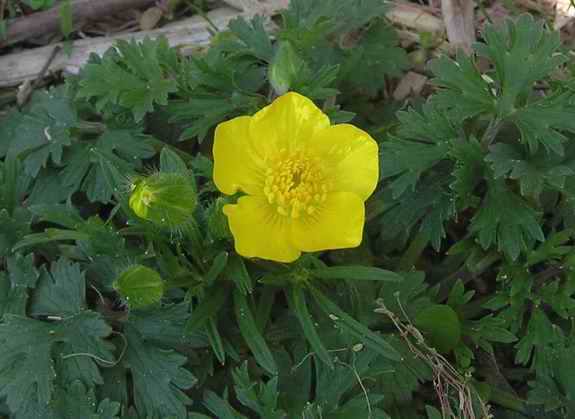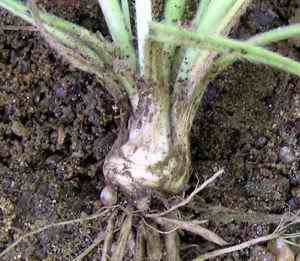|
Return to Hiker's Notebook Home Page
Common Name: Bulbous Buttercup, Blister plant, Saint Anthony's Turnip, Butter flower, Butter rose, Crazy weed, Gold cup, Crowfoot, Butter and Cheese, Bachelor's buttons, Gold knots, Meadow ranunculus - The golden-yellow hue is reminiscent of butter, the petals have a pronounced cup shape, and the root base is bulbous.
Scientific Name: Ranunculus bulbosus - Rana is the Latin word for frog; the suffix form "unculus" conveys a diminutive stature. The generic name therefore literally means "little frog." Pliny the Elder (Gaius Plinius Secundus, a Roman naturalist and writer) is credited with this assignation to indicate that some Buttercup family wild flowers have the same boggy meadow habitat as little frogs. The species name is a Latinized form of bulbous.
The Buttercup lends its name to the order Ranunculales which is comprised of 10 families, 140 genera and about 3,000 species and to one of the ten families (Ranunculaceae) which in turn is inclusive of 35 of the genera and 2,000 of the species; the Buttercup family is predominantly indigenous to the temperate regions of the Northern Hemisphere. The bulbous buttercup is the most common in this area, though it is not native. The plants of Ranunculales are considered by many botanists to be the first evolutionary break from the Magnoliales order, the most primitive of the angiosperms (flowering plants). This evolutionary transition is most clearly indicated in the gradual development of petals from sterile stamens. The more primitive genera like Anemone have only fertile stamens while the more evolved Ranunculuses have both fertile stamens and evolved scales at the base of the petals which have a nectar secreting pit; they are known as Honigbl�tter, or "honey leaves" in Germany.
The golden waxy glow of the buttercup is due to a layer of cells just under the surface of the petal that reflect the orange pollen color. This distinctive almost ethereal luminescence has spawned a number of folk traditions. The most hackneyed is the classic childhood rubric that a yellow reflection on the chin from a suspended buttercup confirmed a love of butter. More thaumaturgic (magical) customs ascribed the positioning of a buttercup adjacent to the neck or smelling the flowers in the light of a full moon to a predisposition to lunacy; the alternative common name Crazy weed is a reference to this superstition. According to the folklore of several different regional traditions, Ranunculus was a young lad who dressed in gold and green who had an exceptionally clear and high-pitched voice. His continuous singing disturbed the wood nymphs who restored serenity to the forest by turning him into a flower.
It is likely that the etiology of the special properties attributed to the
buttercup in folklore is the poisonous composition of many of the plants in
the family. Ranunculus genus plants contain a glycoside with the derivative
name ranunculin that is broken down by enzymes to pr
The toxins of the buttercup also cause contact dermatitis in humans. Beggars once used this property to create blisters to engender sympathy for alms; the name Blister plant reflects this practice. The virulence of toxins to humans has historically been exploited medicinally; protoanemonin is no exception. The rubefacient (redness inducing) properties of the buttercup were used to treat joint pain associated with rheumatism and arthritis. A tincture made for the leaves was applied externally to treat a wide variety of conditions that included alcoholism, chest pain, epilepsy, hay fever, hiccups, sciatica and shingles.
Native Americans also used buttercups (the indigenous R. acris) variously according to local custom and tradition. Medicinally, they made a poultice of the root corm (like that of the bulbous buttercup) to treat skin lesions like boils and abscessed edemas. The Algonquin made a powder of the seeds and flowers to promote sneezing as a palliative for a sinus headache. The Menomini made a red dye by boiling the entire plant in water with bur oak and soaking fabric in the bath to set the color. The Potawatomi made a yellow dye for baskets and mats by boiling the plant and setting the color with clay. The Ojibwe smoked buttercup seeds in their pipes to lure deer to come close enough for disposition with an arrow. |

 oduce a bitter compound
called protoanemonin. When buttercups are eaten by grazing animals, the toxic
oils cause oral irritation and blistering of the esophagus. In severe cases,
gastrointestinal distress can lead to convulsions, paralysis and death.
Dehydration detoxifies the protoanemonin; hay containing buttercups is
therefore not a problem, though the milk from cows that have ingested
buttercups has an acrid flavor and is tinged with red. Apparently swine
are not affected as bulbous buttercups are called Saint Anthony's turnips
because they were eaten by pigs; the bulbous root is turnip-like. Saint
Anthony was a swineherd.
oduce a bitter compound
called protoanemonin. When buttercups are eaten by grazing animals, the toxic
oils cause oral irritation and blistering of the esophagus. In severe cases,
gastrointestinal distress can lead to convulsions, paralysis and death.
Dehydration detoxifies the protoanemonin; hay containing buttercups is
therefore not a problem, though the milk from cows that have ingested
buttercups has an acrid flavor and is tinged with red. Apparently swine
are not affected as bulbous buttercups are called Saint Anthony's turnips
because they were eaten by pigs; the bulbous root is turnip-like. Saint
Anthony was a swineherd.